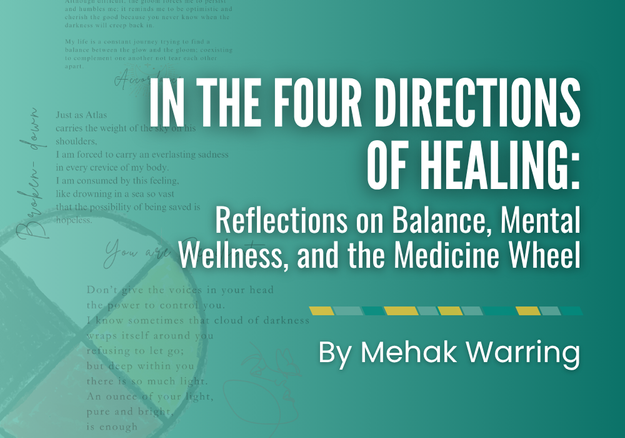In the Four Directions of Healing:
Reflections on Balance, Mental Wellness, and the Medicine Wheel
Mehak Warring | November 10, 2025
Mental health has always been a topic I’ve been deeply passionate about, perhaps because of my own lived experiences or because of the world we live in, where mental health concerns have become increasingly visible among younger generations. As a second-generation South Asian, my perspectives are shaped not only by my cultural background but also by the broader social context in which they exist. These factors intertwine, influencing the ways I understand and experience hardship.
In my final year of my BSc at McMaster University, I had the opportunity to take a community based indigenous health class, which allowed me to combine my passions for advocacy and knowledge translation together, through a form of expression that really resonates with me, creative writing and poetry. Recognizing the ongoing challenges within my own community and the need to address gaps in mental health awareness and care, I wanted to expand my understanding by exploring how mental health is experienced in communities with different histories and lived realities.
Almost two years after my initial work on this project, I’ve been given this chance to revisit my ideas, shaping them to further align with all the teachings I have learned through advocacy work. Hence I was able to add a nuanced perspective to this project, allowing it to grow with me.
The Inequities of Mental Health Care in Canada
In Canada alone, Indigenous people are disproportionately affected by mental health, with suicide rates as high as five to six times that of non-Indigenous Canadians (Ninomiya et al., 2020). Trends suggest that the psychological distress faced by this community could be a result of historical trauma concerning forced assimilation and the influence of colonization, evident factors causing declines in mental health. In addition to these challenges, society and Westernized healthcare tend to be heavily biased and one-sided, adding to the struggles faced by Indigenous people; this community is more likely to experience discrimination and mistreatment due to their cultural background, preventing them from receiving the care they deserve (Childs, 2021). For these reasons, individuals within this community can be more likely to suppress their emotions and not seek help, which results in more crises; since care was not offered earlier on in a welcoming and safe manner, in most cases, health professionals intervene during a mental health crisis, when often it is too late. It is important to recognize that experiences vary widely across Indigenous communities and individuals; while some may navigate these challenges with resilience and access to supportive cultural practices, others may face heightened vulnerability.
Exploring Holistic Approaches to Healing through Poetry
This poetry collection reflects my personal experiences as I engage with holistic approaches to healing. In particular, I was drawn to learning about the Cree, among the largest Indigenous communities in Canada, and how cultural teachings, such as the Medicine Wheel, support healing and resilience through connection, balance, and reflection. While I do not belong to the Indigenous community, this work is written with respect and a desire to learn from their wisdom. Each of the five poems reflects my personal interpretation of the four directions and the center, exploring how they intersect with my experiences and understanding of mental health, identity, and balance.
The five poems outline the following:
- Broken Down – Mental Health as an Issue
Addressing the solution (The Medicinal Wheel)
- Accordance – (Spirit)
- Take a step back and reflect – (Body)
- You are resilient – (Mind)
- To feel is to be Human – ( Heart)
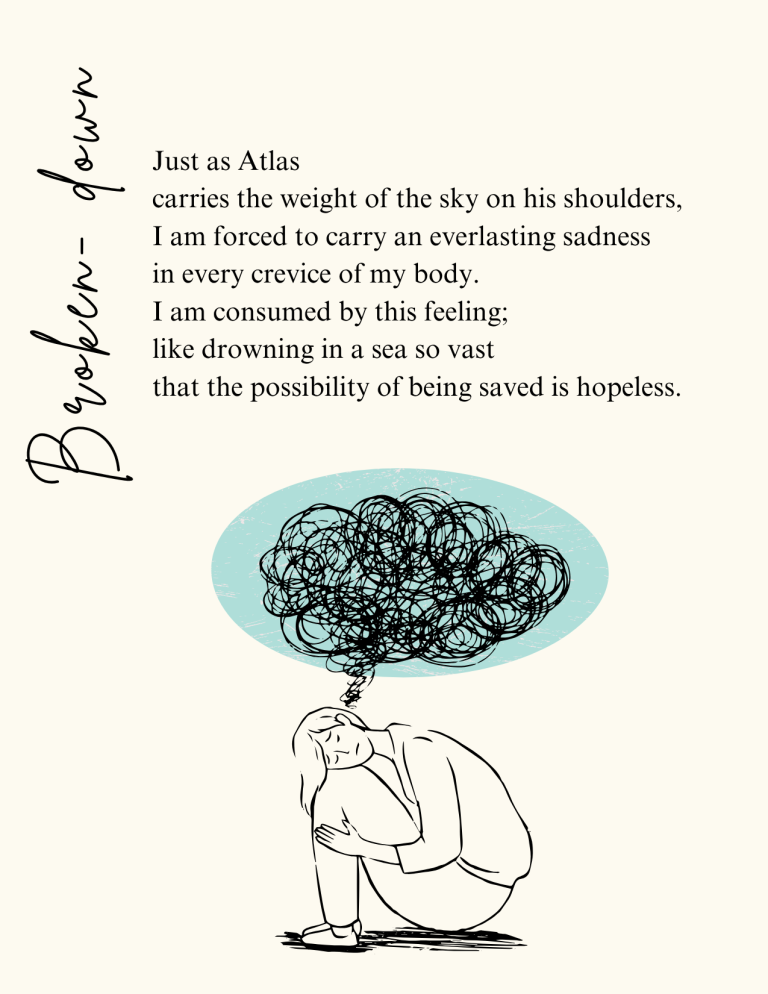
Broken Down explores the ways mental illness can limit one’s potential and dampen the ability to fully engage with life. It conveys feelings of numbness and hopelessness, capturing the isolating nature of such struggles.
The poem uses Atlas as a symbol of this distress, drawing from Greek mythology, where Atlas is condemned to hold up the sky for eternity, becoming weighed down and burdened by the immense responsibility. Similarly, mental illness can make a person feel crushed under the weight of their own challenges, eroding self-worth and distancing them from their former vitality.
The purpose of Broken Down is not to elicit sympathy, but to acknowledge the real, painful impact of mental illness and highlight the urgent need for understanding, care, and intervention.
How many more lives will go to waste until we realize the worth of others?
How many more indigenous people need to suffer in silence until we address these holes within our society?
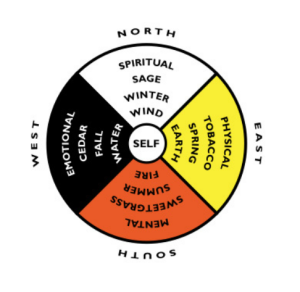
Continue your reading to move through the four dimensions of healing…
The Solution: The Indigenous Medicine Wheel
Despite the adversities that lie within this community, they have tried to persist, to the best of their abilities. Relying on their traditions and cultural values like other Indigenous Communities, the Cree also believe in finding a balance between one’s four states: spirit, body, mind, and heart, to achieve mental peace (Danto & Walsh, 2017). I think it is important to mention that for mental illnesses, this is not the only recommended practice of care, and medical intervention should be considered as well. However, the medicinal wheel can be seen as a holistic approach to improve and stabilize one’s mental well-being throughout their life. The medicine wheel is linked to attaining inner balance by aligning the four dimensions that make an individual (Dalai Lama Center for Peace and Education, 2014). Through the next four poems, I will try to capture the essence of each dimension while highlighting interventions that can be used to strengthen the respective dimension.

Spirit: Spiritual
In the North lies the first dimension, the spirit. This section of the medicine wheel focuses on the energies within one’s life, both positive and negative, and how they coexist (Smith, 2018). It is important to find a balance between these energies, as too much exposure to one compared to another can take a toll on one’s life. “Accordance” emphasizes the presence of various energies within one’s life, the glow and the gloom, and how they both exist within an individual simultaneously. As the title suggests, an individual must find a balance between both these states to achieve inner harmony. No matter how difficult it may seem, both the glow and the gloom are necessary for one’s life, not only in terms of humility and gratitude but also to allow one to persist and move forward. As the dimension of the spirit entails, this poem is meant to show that we must find a balance between the good and the bad since experiencing both is inevitable; through this poem, I hope to have captured what it is like to be stuck between two states, further emphasizing the significance of Indigenous traditions about inner reflection and cleansing one’s spirit.
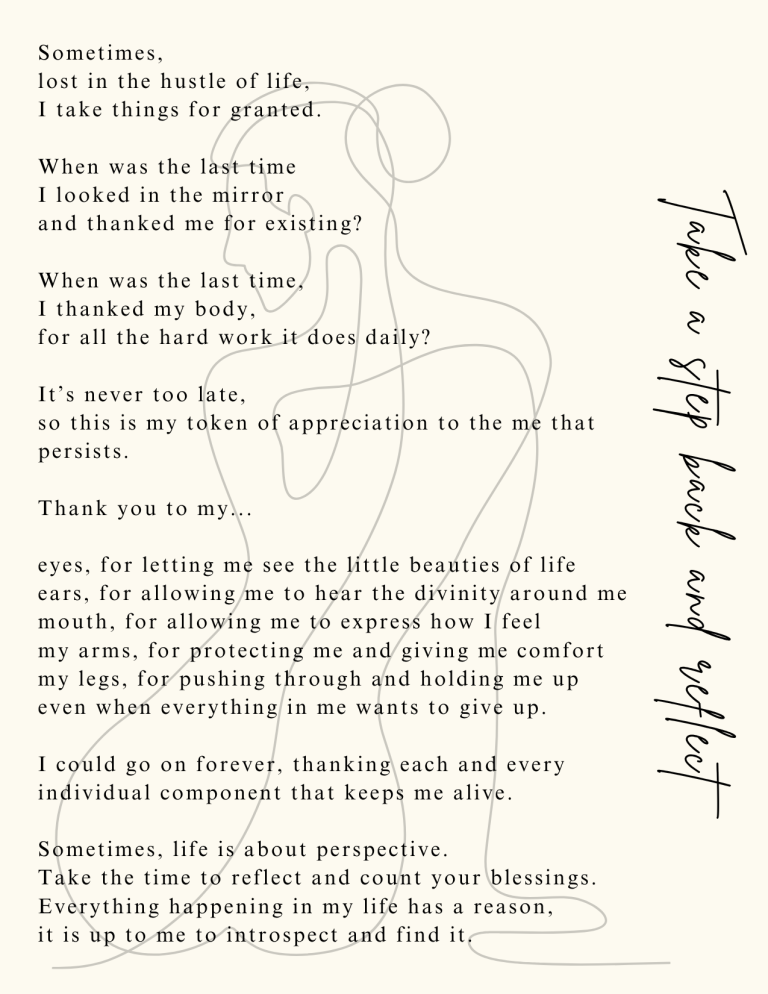
Body: Physical
In the East lies the second dimension, the body. This section of the medicine wheel emphasizes the need to care for one’s physicality; this entails all the organs and body systems that work together to ensure that one’s body functions properly (Smith, 2018). To achieve balance, one must take care of their body, whether that be through physical activity, proper rest, setting a routine, or nourishing themselves through a balanced diet. Therefore, it is implied that an individual should treat themselves with love, care, compassion, patience, and gentleness to achieve a healthy physical state. “Take a step back and reflect”, focuses on the need to not only introspect but also realize everything that is being taken for granted. At times, it is very easy to be influenced by self-doubt, others’ perspectives, and societal standards, changing the way one perceives oneself; one may question their features and overanalyze other aspects of one’s body. However, there is so much the human body does daily that needs to be considered. From waking up in the morning to taking in a fresh breath of air to allowing one to self-navigate the world, the human body works so hard to keep one alive and functioning properly. This poem emphasizes how important it is to not only nurture our bodies but the need to alter our perceptions of ourselves to be more loving, grateful, and compassionate.
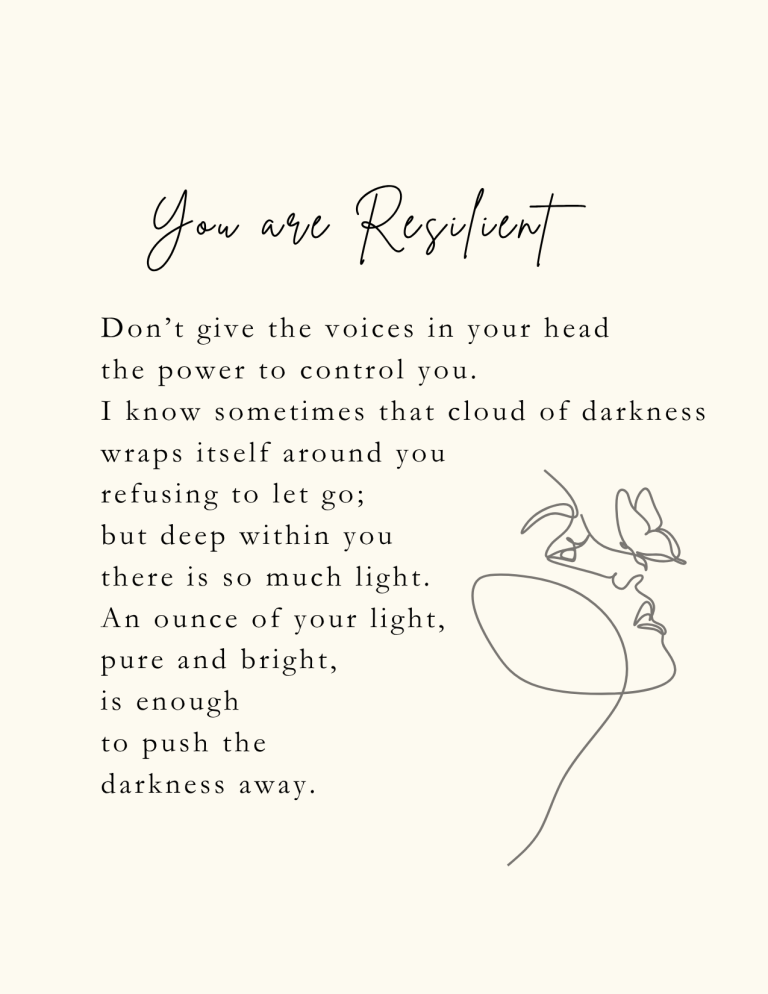
Mind: Intellect
In the South lies the third dimension, the mind. This dimension of the medicine wheel focuses on attaining inner peace by working on healing one’s thoughts and the overall state of their mind (Smith, 2018). The focus of this dimension is on self-empathy, introspection, allowing one to feel and overcome, and self-compassion. “You are Resilient” is a poem about surviving the toughest of times, even when it seemed as though things wouldn’t work out. This poem is about inner strength, perseverance, and not giving up, depicting the constant battle one must deal with when struggling with poor mental health or mental illness. I wrote this piece to describe how it feels to trust yourself and believe that things will be okay, regardless of the circumstance, which is how I have gotten through the toughest of times. As the dimension of the mind focuses on finding a sense of self to partake in self-care, with this poem I tried to capture the journey of life and how it is inevitable to go through hardship, but how one takes on adversity determines the course of their life, therefore having a set of tools and affirmations to fall back on can make all the difference.
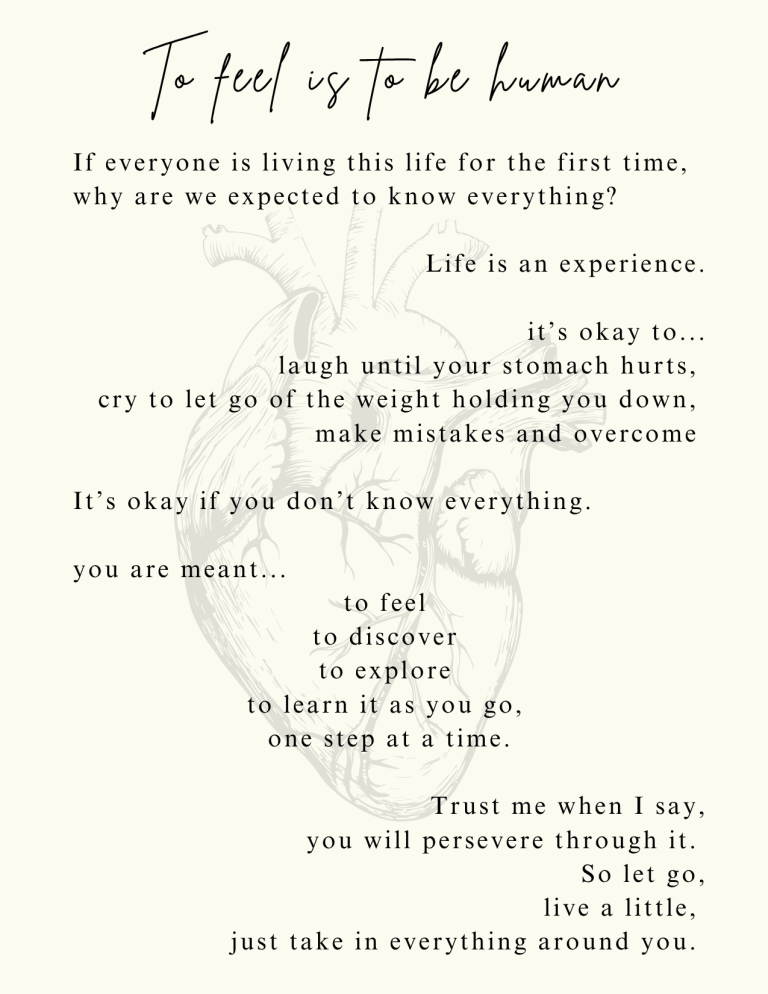
Heart: Emotions
In the West lies the fourth dimension, the heart. This section of the medicine wheel represents all the emotions that make us human, which are linked to self-expression, self-esteem, coping mechanisms, and how all these factors impact one’s ability to have a positive attitude and healthy relationships (Smith, 2018). Therefore, implied strategies are to engage in emotional introspection, active listening, and open communication so that individual feelings are heard and respected. “To feel is to be human” expresses the novelty of life and, at times, the burden of feelings. It emphasizes the need to express one’s emotions and how, despite what society says, everyone is allowed to feel. This piece represents not only the journey of life but also showcases how the ups and downs make you human, and how only through hardship, mistakes, and trial and error can one move forward and grow as an individual. These principles capture the essence of the heart dimension of the medicine wheel, reminding individuals that it is necessary to feel to attain balance and inner stability.
References
Childs, R. ( 2021, March 8). Behind the headlines: A look at Indigenous mental health. Eli’s Place.
Dalai Lama Center for Peace and Education. (2014). Lessons from the medicine wheel: Well-being is balance. Heart-Mind Online.
Danto D., &; Walsh R. Mental health perceptions and practices of a Cree community in northern Ontario: A qualitative study. Int J Ment Health Addict. 2017;15(4):725-737. doi: 10.1007/s11469-017-9791-6. Epub 2017 Jul 17. PMID: 28798552; PMCID: PMC5529477.
Ninomiya,M.M., George, N.P., George, J., Linklater, R., Bull, J., Plain, S., Graham, K., Bernards, S., Peach, L., Stergiopoulos, V., Kurdyak, P., Mckinley, G., Donnelly, P., Wells, S.(2020). A community-driven and evidence-based approach to developing mental wellness strategies in First Nations: a program protocol. Res Involv Engagem, 6(5).
Smith, C.M. ( 2018, October 3). How I use the teachings of the medicine wheel in my healing journey. HealthyDebate.
 Mehak Warring OCIC Youth Policy-Makers Hub Member
Mehak Warring OCIC Youth Policy-Makers Hub Member
“In a world full of billions of lights, who decides who gets to shine?” For Mehak (she/her), this question fuels her passion for advocacy and empowerment, working toward a society where differences are celebrated rather than silenced. With a BSc in Life Sciences, a Minor in Social Justice and Inclusive Communities, and a Certificate in Science Communication from McMaster University, she bridges research and advocacy to promote mental well-being and resilience.


